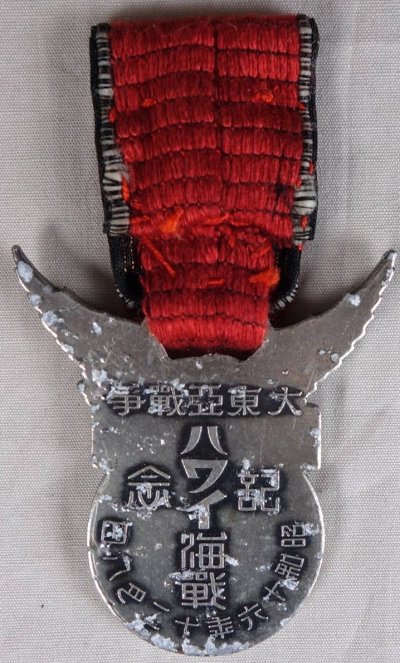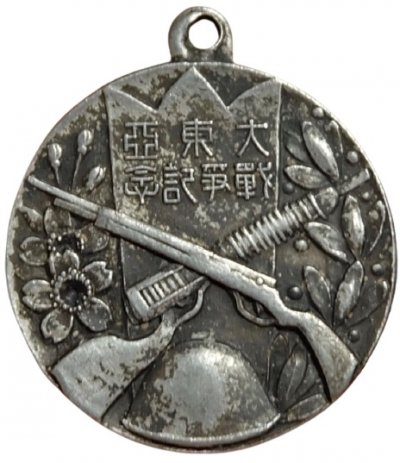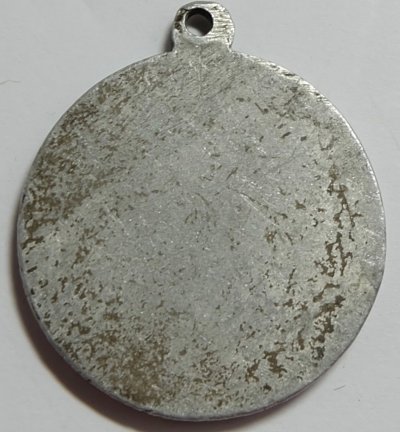Very interesting commemorative watch fob made out of Netherlandish 1932 silver 2 1/2 gulden coin.
Reverse engraved
ボルネオ上陸 - Borneo Landing
記念 - Commemorative
Miri, a city in Sarawak located in northern Borneo, fell to 2,500 Japanese on 17 Dec 1941, after two days of fighting. The small garrison of Dutch troops were no match for the Japanese. A week later, the Japanese 35th Infantry Brigade and 124th Infantry Regiment led by Major General Kawaguchi headed for the Sarawak capital, Kuching.
Borneo, the third largest island in the world, was known for its rich natural resources, including oil. The location was also of strategic value, as the island stood in the path of shipping between East Asia and Australia, to India, and to west beyond. Also, in the age of aerial warfare, the short distance between Kuching and Singapore meant the capture of the capital city would allow Japan ready access to attack Singapore and Malaya by air from another base.
"The best I could do was to promise to send them a few anti-aircraft guns... not that I expected anti-aircraft guns to be much practical value", said Lieutenant General Arthur Percival in 1941 regarding British Borneo's defenses against a possible Japanese invasion. Perhaps as a result of his belief, the Japanese air support to the ground troops went largely unchallenged. The Japanese troops arrived at Kuching on 24 Dec, but only to find the airfields at Kuching destroyed by the British before their retreat. At day break on Christmas Day, Japanese troops fully controlled the city of Kuching, and captured a stock of fuel oil to replenish their supplies. By 31 Dec, most of British and Dutch troops retreated to the Dutch airfield at Singkawang II. Northern Borneo was to be completely under Japanese control after the 6 Jan 1942 Japanese landing at Brunei Bay.
On 11 Jan 1942, one day after Japan declared war on the Netherlands, Major General Shizuo Sakaguchi's troops landed on the island of Tarakan just off the northeast side of Borneo, aiming to take control of the 700 oil wells, oil refinery facilities, and airfields on it. Lieutenant Colonel S. de Waal, commander of the Dutch garrison on the island, detected the invasion fleet a day before the landing, and decided to destroy oil fields before the Japanese could capture them. After mounting a brief resistance, Colonel Kyohei Yamamoto's troops and the men of the 2nd Kure Special Naval Landing Force established a strong beachhead and penetrated the Dutch defense. The Dutch defenders that still remain surrendered on 12 Jan, but were executed by the Japanese in retaliation for the destruction of the oil fields.
Balikpapan, a coastal city on the east coast of Borneo, was the center of Borneo's oil industry. It was cut off from the rest of Borneo by terrain, so that Rear Admiral Shoji Nishimura's Fourth Destroy Squadron was tasked to cover a landing operation to take the city. Nishimura's convoy survived a submarine attack by USS Sturgeon without much damage, and reached Balikpapan to unload the troops. As Nishimura's ships went off to chase down false signs of Allied destroyers, United States Navy's Task Force 5 of the Asiatic Fleet under the command of Rear Admiral William Glassford showed up and attacked the landing forces amidst the vulnerable unloading phase. The four American destroyers opened fire at a long range, and the shots were inaccurate. When they approached the Japanese ships and launched their torpedoes, scores of them were defective. They only managed to destroy one of the three Japanese patrol boats and four of the twelve transports present, though to their credit they did manage to delay Japanese landing operations and gave the defending troops on land a bit more time to prepare the defenses. Balikpapan fell on 24 Jan.
Throughout the following few months, Japan repeated attacks on Singkawang II, but the British 2nd Battalion's 15th Punjab Regiment fought back fiercely, holding their ground. Allied forces there surrendered on 1 Apr 1942.














